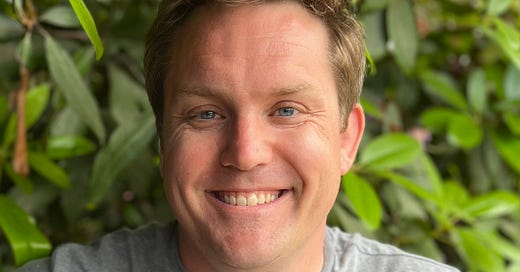Q&A with After Dinner Conversation author, Dustin Grinnell
A bite-sized interview for your Sunday morning.
If you would like to be profiled in this newsletter, here’s how.
Read Dustin’s story, “Going Through the Motions”:
Click the image to get your copy!
Want to support ADC and its authors?
Q&A
What is your After Dinner Conversation short story about?
A: “Going Through the Motions” is about a middle-aged man named Graham who falls out of love with the self-help industry and yet finds unexpected inspiration from a motivational speaker. He then creates his own movement based on a series of thirty-three yoga-like maneuvers. After inspiring millions and achieving fame and fortune, Graham decides to leave it all behind, urging his followers to find their own meaning in life.
What was the inspiration for this story?
In my 20s, I gorged myself on self-help literature but I realized these books weren’t making my life any better. They were just making me hungrier for more self-help books. In “Going Through the Motions” that’s what Graham is going through. After he goes to California and fails to make it as a screenwriter, he returns to Boston to process the failure and realizes that he no longer responds to self-help. Ironically, he’s inspired by a self-help guru to invent his own philosophy that becomes an American movement.
Where did you get the idea for your main character building this philosophy around a series of yoga movements?
The idea for a series of yoga-styled movements actually came from the TV show The OA in which characters perform a series of five movements that can transports a person’s soul to another dimension and sometimes heal or revive deceased people. In one powerful episode, a character tries to bring back his dead friend. I was surprised to see that people had learned the five movements from the show and were performing them for fun, but also for their potential healing properties in places they felt “needed healing,” often with many other people, like a group prayer. I’ve always found group prayers interesting with the idea being that meditating or praying together with a common mantra may send out a “healing force.” In my short story, Graham’s followers perform the movements in front of places like financial firms on Wall Street and along picket lines at corporations.
This story is part your book, The Healing Book, a collection of 13 short stories centered around self-discovery and healing. How did the main character heal?
One of my favorite movies is Forrest Gump. It’s wildly entertaining and has so much wisdom in it. My favorite segment of Forrest’s life is his running days in which he runs around the United States for three years, and it becomes a phenomenon that inspires people to join for fun and purpose. Essentially, he starts a cult. People who run with him attach their own meaning to their running. But Forrest isn’t running for philosophical or ideological reasons. He’s running for emotional reasons. The love of his life, Jenny, came home to stay with him for a while; Forrest calls this the happiest time of his life. But after becoming pregnant with Forrest’s child, Jenny takes off. One day, Forrest steps off his porch, starts running and doesn’t stop for three years. Reflecting on why he was running, Forrest says his mother always said that we have to put the past behind us and he thinks that’s why he was running. In “Going Through the Motions,” Graham had to make peace with his failures and try to find out who he really is. Just like at the end of Forrest’s running, when he stops running and leaves his running partners perplexed, Graham also walks away from the movement he began, saying that his members need to find their own meaning now. Don’t we all have to invent our own meaning in life?
Which philosophy or philosopher most aligns with your own beliefs?
I don’t believe there’s any intrinsic meaning to a human life, only the meaning we decide to give to it. This is one of the core ideas of existentialism, a philosophical tradition that deals with matters such as anxiety, death, authenticity, isolation, and finding meaning in one’s existence. In “Going Through the Motions,” Graham develops a new set of values based on ideas put forth by existentialist philosophers like Friedrich Nietzsche, one of my favorite philosophers, and whose house I visited in 2023.
I like existentialism because isn’t just a philosophy; it’s also a literary movement, led by great writers, many of whom I’ve enjoyed reading in recent years. These authors include: Jean-Paul Sartre and his novel, Nausea, and play, No Exit; Albert Camus’ novel, The Stranger, and his philosophical treatise, The Myth of Sisyphus; Fredrick Nietzsche’s novel, Thus Spoke Zarathustra, and excerpts from his books; Franz Kafka’s The Metamorphosis, and Fyodor Dostoevsky’s short story, “Notes from Underground.”
Often, I’m more attracted to contemporary books that popularize the literary works of existentialist thinkers, as they make their ideas more accessible. In this regard, I’ve enjoyed reading nonfiction books like Hiking with Nietzsche: On Becoming Who You Are, At the Existentialist Café by Sarah Bakewell, and Irrational Man by William Barrett.
If you want to hear a short story where a character navigates an existential crisis by delving into existentialist literature, I welcome you to tune in to my podcast, Curiously, and listen to “Searching for Meaning in the Stars.”
Is there any standard publishing or writing advice that you disagree with? Or any standard advice that you feel is too often neglected?
The old adage “writing is rewriting” is too often neglected. A lot of people feel like most writers just sit down, crank out a story and hit publish. But that’s far from the truth.
I always like looking at the picture of Ernest Hemmingway holding up a page of his work as he’s revising. The page is filled with marks—the many places where he’s improving the language, rearranging words or phrases, or removing what’s unnecessary.
Most published work you read in books, magazines, literary journals, and other publications have gone through numerous iterations before publication. Writing is rewriting. All writers I know are neurotic revisers.
My short story, “A Case of Aphantasia,” which is also in The Healing Book, went through about twenty drafts. I rewrote the story several times. Then I submitted it to be workshopped by peers in my MFA program. After hours of discussion, I incorporated their feedback and did a couple more drafts. Then I sent it to my freelance editor, who tinkered with sentences and pointed out flaws in the logic, among other things.
When Ars Medica finally accepted the story for publication, their editors had their own feedback, prompting me make the dialogue more realistic, improve character descriptions, make the character choices more plausible, and alter the ending. After incorporating the new feedback, I sent it back to my freelance editor again for polishing. Before the story was published, the journal proofread the piece one final time.
This process took two years.
The lesson is that writing and rewriting can’t be separated. I always urge people who want to write to get comfortable with the notion that their original ideas will change. You’ll revise sentences and paragraphs as you write, and it’ll be okay until tomorrow, when you might change it more. Then you might look at it in a few weeks and change it again when you see a new way to make it clearer or more interesting. Even after publication, you’ll probably see ways you could have improved it.
Knowing you’ll always tinker with your story should take the pressure off. You don’t have to get everything right on the first, second, or even third draft. The story and your sentences improve as you keep going back to fix mistakes, remove repetition, add details, and make things more specific.
Dustin Grinnell is a writer based in Boston. He’s the author of The Healing Book (Finishing Line Press), The Empathy Academy (Atmosphere Press), The Velvet Ghetto (Blue Cubicle Press), and host of the podcast, Curiously.
In 2023, Dustin brought his essays together in a book, Lost & Found: Reflections on Travel, Career, Love and Family, a collection of 25 essays in which he writes about discovering amazing places—and bit by bit, himself.
Learn more about his work on his website, and follow him on Instagram @dustin.grinnell and X @DustinGrinnell.









I'm glad that part resonated with you, Celia. I'm a firm believer in revision—refining and iterating until a piece of writing works. I’ve only taught creative writing in a few workshop settings at conferences, but never in a formal capacity. I’d love to teach writing at the high school or college level, but after so many years in corporate writing, I’m not quite sure how to make that transition.
That’s awesome advice, about rewriting. I say that all the time, but, you’re right: way too many writers stop at a second draft (sometimes a first). Have you taught creative writing?